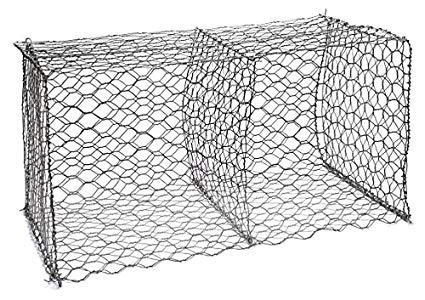A gabion wall is a wire cage filled with rocks then stacked usually in a retaining wall, they are about a 3-foot cube in size & stones about 8-inch diameter.
They are typically placed around streams as an erosion barrier or retaining wall, placed by crane, and backfilled with dirt.
It is cheaper than a stone or cement wall, also used as a bulletproof wall in military engineering because it can be erected rapidly.
Here we will learn about gabion wall, components of gabion wall & much more.
Introduction to gabion wall:
Gabion walls are typically battered (angled back towards the slope) or backward alongside the slope, rather than steep.
They can be used to direct the movement of flood water around a vulnerable construction.
Gabion stepped weir is often used for river training works and flood management; the stepped design will increase the speed of energy dissipation within the channel.
Types of Gabion Wall:
These walls are selected based on their cost and function, and the common types of gabion wall as follows:
1. Gabion Basket:
It is a pure wire mesh manufactured in box sizes and various sizes, they are used in highway and railway works.
It is economical if filler material is available or mines are near the project site.
2. Gabion Mattress:
They are also known as reno mattresses gabion wall, it has a lower height than the other types.
It is employed in channel coating to prevent corrosion hence it deals with wave and erosion induced velocity.
The standard size is 6 meters long, 2 meters wide, and 0.3 meters high.
3. Gabion Sacks:
These varieties of gabions are formed rapidly, it is a porous and flexible structure.
They are used in hydraulic works in emergency situations.
4. Gabion Wire Mesh:
They are used to protect the rock and stone falls on the highway and railway surfaces.
It maintains the stability of the slope, adjacent to highways and railways used as anti-erosion gradients.
This combination with geogrid reinforcement increases the strength of embankment soil.
Advantages of GABION WALL:
Aesthetic View:
Gabion walls look natural and fit in the environment using natural materials.
Water permeability:
They are permeable and does not get damaged by the passage of water.
Efficiency:
Gabion walls capacity can be increase with vegetation fills and strengthens the wall structure.
Durability:
Stone blocks are the materials used due to their longevity, strength, and stability.
Typically, the stone is chosen because of its aesthetic characteristics or use of this material produced from the excavation.
Environmentally friendly:
Gabion walls can be filled with recycled materials such as concrete or rock that is useless from construction projects will reduce landfill and fuel consumption.
Using materials created by excavation reduces the cost of procurement and transportation significantly.
Permeability:
It provides automatic and natural drainage, eliminating the need for installation of drainage pipes.
Strength:
They are strong enough to resist flood forces, ice, and earth pressures.
Flexibility:
This characteristic allows the gabion walls to settle and deform without failure and effectively damage.
Disadvantages of gabion Wall:
- When not placed properly in the landscape, the gabion can fail quickly and increase erosion.
- When used for riverbank stabilization, the gabion wall increases the water flow rate and erodes the bank immediately downstream.
- Some gabion baskets in the markets are defective and will disintegrate within a few months.

Applications of Gabion Wall:
- Retaining structures are used in the dams and carvings such as retaining walls, revetment, and foot walls.
- They are used to corrosion prevention structures to protect the sea walls, riverbank, canal banks, dams, weirs, reservoirs, and lakes.
- The cylindrical metal gabion is used in the creation of a dam or foundation.
- They are used as a noise inhibitor.
- A gabion wall is used as a temporary flood wall.
- They are also used to change the direction of flood water around a weak structure.
- Stepped gabions enhance the power dissipation in channels.
- It is used for aesthetic functions.
- It is used in a retaining wall at the toe of an active slope.
- It is used to reduces and tries to stop weathering or erosion.
Also read: Masonry Wall, Load Bearing Wall & Parapet Wall
Conclusion:
Gabion retaining wall is much innovative as compared to the regular walls as they are eco-friendly to our environment.
These walls are strong, flexible, dimensionally stable and quickly and easily assembled .
It is the most environmentally friendly and economical method for construction the retaining walls.

Related Posts
Rock Quality Designation(RQD): Building Strong Foundations
Spread Footing
Masonry Cement
Plain Cement Concrete
Concrete Efflorescence
Concrete Pile
Stepped Footing
Fineness Modulus of Coarse Aggregates
Difference between Condo and Apartment